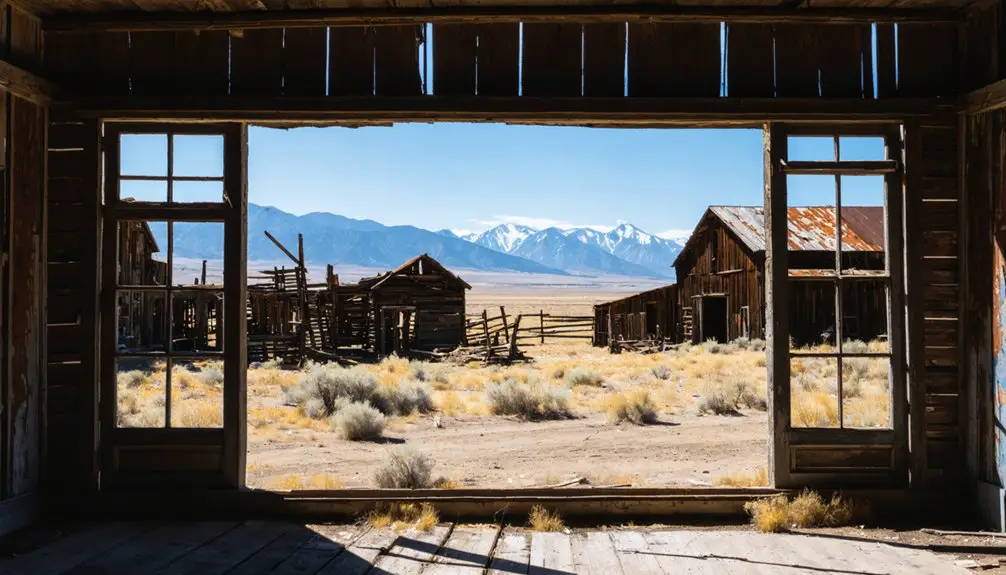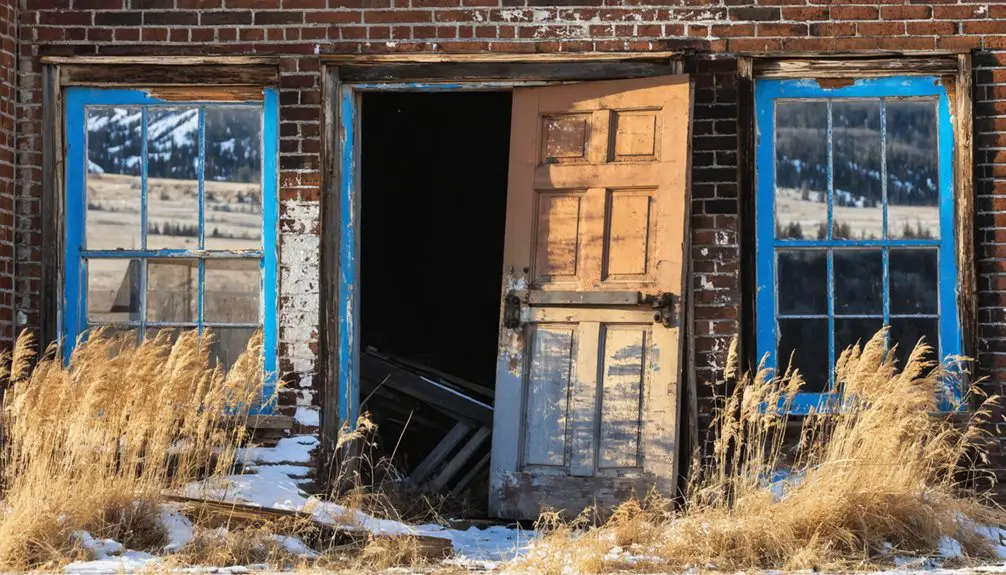You’ll discover Coloma ghost town at 7,000 feet in Montana’s Garnet Range, where gold strikes in 1865 sparked mining operations that peaked in the 1890s. Originally called Mystery Camp, this settlement yielded $250,000 in precious metals before closing in 1916. Today, you can explore authentic miners’ cabins, a log barn, and mill sites with historic firebricks and timbers. Coloma’s enigmatic past and archaeological treasures hold many untold stories.
Key Takeaways
- Coloma is a historic mining ghost town established in 1893 in Montana’s Garnet Range, originally known as Mystery Camp until 1906.
- Located at 7,000 feet elevation, the town prospered during the 1890s gold rush, producing approximately $250,000 in precious metals before declining.
- The site features preserved structures including three miners’ cabins, a log barn, boarding house, and historic mill sites with original equipment.
- Mining operations ended by 1916 due to wartime priorities, and harsh conditions at high elevation contributed to the town’s eventual abandonment.
- Visitors can access Coloma via Garnet Range Road, with seasonal restrictions and recommended exploration of remaining structures on foot.
The Birth of a Mining Settlement
When gold was discovered in Elk Creek and Bear Gulch in 1865, the foundations for Coloma’s mining settlement were laid.
You’ll find the settlement origins rooted in the rugged Garnet Range of Missoula County, where early placer gold discoveries sparked a rush that drew thousands of prospectors to the area.
While miners initially scattered across the landscape following promising gold deposits, the mining community didn’t officially establish itself until 1893.
The settlement truly boomed in 1897 when lode deposits were discovered, bringing new life and prosperity to the area.
The town emerged about two miles north of Garnet at a challenging high-altitude location.
The town’s stamp mills and crushers processed significant amounts of ore before it was sent to local smelters.
Early records of Coloma’s beginnings remain limited and mysterious, with many details preserved only through oral accounts.
Gold Rush Glory Days
Although initial gold discoveries sparked excitement, Coloma’s peak mining activity didn’t materialize until the 1890s.
Despite early gold finds generating buzz, Coloma had to wait until the 1890s to see its mining operations truly flourish.
Old newspapers and mail found in the structures reveal that mining operations continued through the mining boom of the 1920s.
You’ll find evidence of ambitious mining techniques throughout the district, where miners extracted approximately $200,000 in gold ore using both placer and vein mining methods. The installation of narrow-gauge railroad tracks and advanced ventilation systems shows how seriously investors took Coloma’s potential. The New York-Montana Gold Mining Company played a crucial role in developing the area’s mining operations.
Key mining developments during the glory days included:
- Ten and twenty-stamp mills for crushing ore
- Extensive tunnel networks targeting the Mammoth vein
- Implementation of industrial pumping machines
- Construction of infrastructure worth over $1 million
Despite these investments and the discovery of mixed ore deposits containing gold, silver, lead, and zinc, Coloma’s overall precious metals production reached only $250,000, falling short of investors’ expectations.
Life in the Mountain Mining Camp
You’ll find evidence of challenging daily life in Coloma’s remaining cabins, where miners insulated walls with newspapers and catalogs to survive the harsh mountain winters.
Working the mines at this high elevation meant dealing with limited seasonal access, as the mining roads were only open from May through January depending on snow conditions.
The presence of two ore-crushing mills, ventilation systems, and pumping machines shows how miners adapted their routines around the available technology to extract gold, silver, lead, and zinc from the mountain’s deposits. Despite their efforts, the Mystery Camp yielded only about $250,000 in total mineral production throughout its history.
Daily Mining Camp Routines
Life in Coloma’s mountain mining camps revolved around intense physical labor and basic survival needs. You’d start your day at dawn, heading to the mines with basic mining equipment like picks and shovels. Similar to Butte’s Miners Union, workers fought for better conditions and wages in these harsh environments. The work was grueling, often in harsh conditions ranging from icy streams to sweltering underground shafts. Like the early days of Neihart, miners packed ore on horseback to smelters.
The camp’s social dynamics centered around essential services and gathering spots:
- Blacksmith shops for repairing crucial tools
- Assay offices where you’d test ore quality
- Eating houses providing basic sustenance
- Saloons serving as community hubs
You’d conduct transactions using small amounts of gold dust, as cash was scarce.
After long shifts, you’d return to simple accommodations – tents or basic log cabins. Despite the harsh conditions, you’d find camaraderie among fellow miners from diverse backgrounds, all sharing similar daily struggles.
Hardships at High Elevation
Perched at 7,000 feet above sea level, Coloma’s mining camp endured some of Montana’s harshest living conditions. You’d have faced year-round cold temperatures, sudden weather changes, and the constant threat of altitude sickness while maneuvering the steep, rugged terrain.
High altitude living meant you were often cut off from the outside world during winter months when snow and ice made travel nearly impossible. You’d have relied on improvised insulation like old newspapers to keep warm in your cabin.
The thin mountain air and extreme elevation differences of 2,000-2,500 feet complicated every aspect of mining operations, from hauling ore to building infrastructure. Despite having amenities like reading rooms and a 400-volume library, the harsh environment and isolation ultimately drove many residents away, contributing to Coloma’s eventual abandonment by 1960.
Mining Operations and Methods
Mining operations in Coloma centered around several major mines, with the Mammoth Mine emerging as the district’s largest producer after its 1896 opening.
Mining techniques shifted from surface placer mining to lode extraction as miners pursued rich vein deposits. Chinese miners were known for their meticulous reworking of abandoned claims. You’ll find evidence of extensive ore extraction systems, including 10-stamp and 20-stamp mills used to crush valuable minerals.
The district’s mining infrastructure included:
Mining innovation drove Coloma’s success, with extensive infrastructure networks supporting complex underground operations throughout the district.
- Shafts extending 350 feet deep with 500-foot lateral drifts
- Complex water pumping systems and drainage tunnels
- Narrow-gauge railroad tracks for ore transportation
- Ventilation systems throughout the underground workings
Despite technological advances, the mines faced persistent challenges with water infiltration.
The Mammoth Mine’s most productive period came between 1905-1907, yielding annual returns of $150,000, though much gold was lost in the tailings due to inefficient processing methods.
The Rise and Fall of Coloma’s Economy
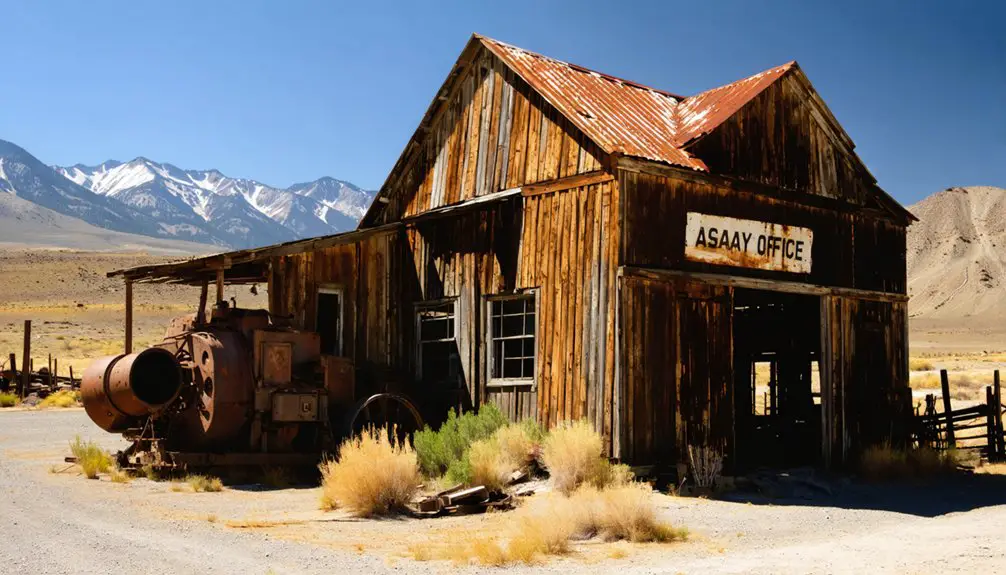
The discovery of gold and valuable minerals in the 1860s transformed Coloma into a bustling economic hub. You’ll find evidence of this prosperity in the 10-20 stamp mills that processed ore and the substantial buildings with root cellars that housed the town’s middle and upper-class residents.
Unlike rowdier mining towns, Coloma’s economic character featured fewer saloons, women-owned businesses, and a 400-volume library.
However, economic fluctuations plagued the town’s sustainability. The Mammoth and Comet mines, while producing up to $250,000 in minerals, struggled with profitability due to inefficient extraction methods. Mining operations remained sporadic, and by 1916, wartime priorities ended major operations.
Today, you can trace Coloma’s economic trajectory through rusting infrastructure and archaeological artifacts, remnants of a once-prosperous community that couldn’t overcome the challenges of mining sustainability.
Notable Structures and Landmarks
Today you’ll find a compelling collection of historic structures dotting Coloma’s landscape, from the imposing remains of stamp mills to well-preserved miners’ cabins.
The mining infrastructure reveals the town’s industrial heritage, with visible shaft entrances, ventilation systems, and remnants of narrow-gauge railroad tracks that once transported precious ore.
Originally known as the Mystery Camp during its active years between 1893 and 1906, the town remained active until 1916 before falling into disuse.
Among the most significant historical buildings still standing:
- Three authentic miners’ cabins with walls insulated by 1920s newspapers
- A large log-sided barn that supported local agriculture
- A boarding house containing original furniture
- Two mill sites featuring historic firebricks, timbers, and an iron boiler
The site’s most prominent mine, the Mammoth, operated since 1896 and yielded approximately $200,000 in gold, making it a centerpiece of Coloma’s mining legacy.
Archaeological Discoveries
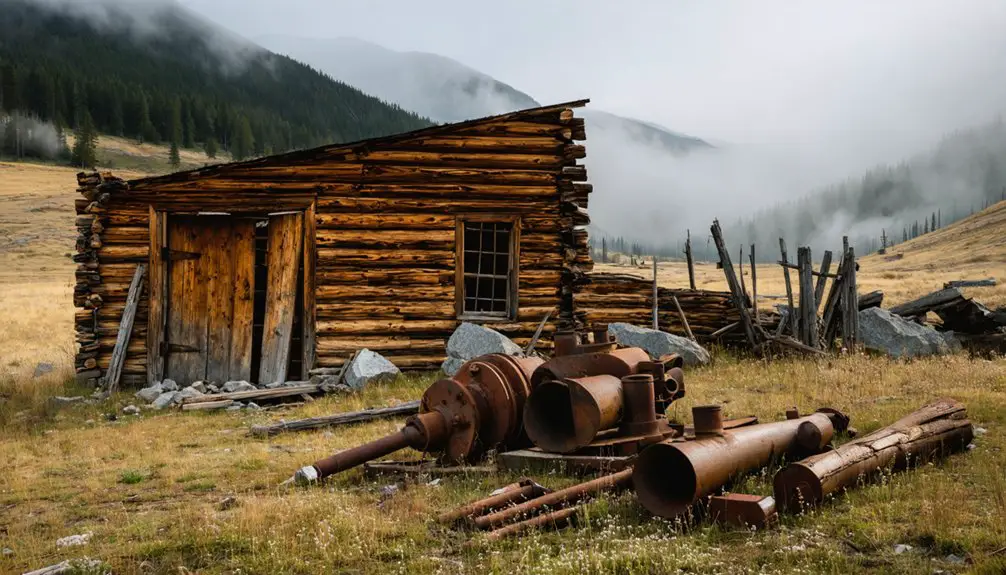
You’ll find evidence of Coloma’s past through extensive archaeological excavations conducted by the University of Montana’s Archaeology Department in 2010 on Myrna Fessler Leipheimer’s claims.
The discoveries include numerous domestic items and mining equipment that paint a picture of daily life during both the town’s peak mining operations and its 1930s Depression-era occupation.
These artifacts, along with the remains of stamp mills and mining shafts extending 350 feet deep, have helped researchers fill critical gaps in Coloma’s documented history where written records were sparse or missing.
Unearthed Historical Artifacts
Archaeological excavations at Coloma have revealed a treasure trove of mining equipment, domestic artifacts, and cultural remnants spanning from the late 1800s through the 1930s.
You’ll find evidence of both industrial and domestic life through carefully unearthed items that showcase the mining camp’s evolution.
Key artifact discoveries include:
- Rusting ventilation systems and narrow-gauge railroad tracks that illustrate industrial mining operations
- Depression-era household items from a 2006 trash dump excavation
- Mail-order catalogs used as cabin insulation, dating structures to the 1920s-1930s
- Remnants of stamp mills and ore processing facilities that processed an estimated $200,000 in gold
These discoveries, analyzed through modern excavation techniques, provide vital insights into the daily lives and economic conditions of Coloma’s residents during the mining boom and subsequent Depression era.
Campus Research Projects
Three major research initiatives by the University of Montana have transformed our understanding of Coloma’s past. Through campus collaborations led by Professor Timmons and Dr. Kelly Dixon, archaeologists unearthed essential evidence of mining operations and community life spanning the late 1800s to mid-1900s.
Student engagement peaked in 2006 when graduate researchers focused on a Depression-era trash dump, revealing insights into survival strategies during economic hardship.
You’ll find their discoveries particularly fascinating – from narrow-gauge railroad remnants to newspapers used as cabin insulation from the 1920s and ’30s.
Despite sparse mining records and mysterious local accounts, the university’s archaeological teams have pieced together evidence of 10 and 20 stamp mills, inefficient gold extraction processes, and daily life in this remote mining community.
Preservation and Historical Recognition
While many Montana ghost towns have faded into obscurity, Coloma has received substantial preservation attention through partnerships between the Bureau of Land Management and the University of Montana.
Through community involvement and sustainable tourism initiatives, preservation efforts have secured $72,000 in funding for research and educational activities.
Key preservation accomplishments include:
- Implementation of GIS technology for digital archiving
- Archaeological field schools and systematic research since 2006
- Creation of virtual, interactive ghost town representations
- Documentation of unique building practices, including newspaper-insulated walls
Despite these efforts, you’ll find Coloma’s physical structures continue to deteriorate more rapidly than nearby Garnet ghost town.
The site’s remote location and limited stabilization funding present ongoing challenges for maintaining this historic location, which yielded between $200,000 and $1 million in precious metals during its mining era.
Accessing the Ghost Town Today
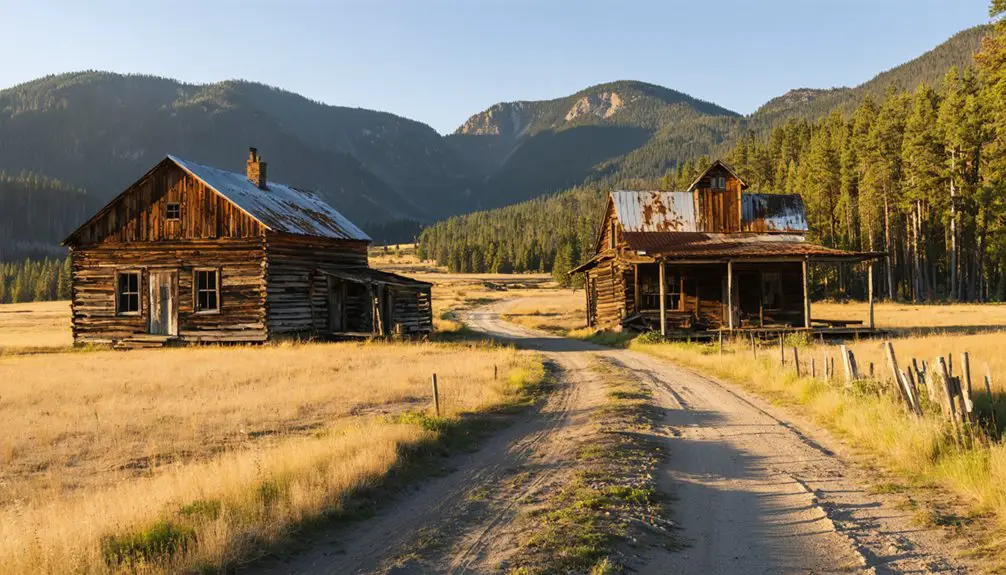
Located in Montana’s rugged Garnet Range, Coloma ghost town is accessible via the Garnet Range Road, which forms a 13-mile circular route southeast of Highway 200.
You’ll need to plan your visit carefully, as road conditions can be challenging. The gravel roads are steep, narrow, and rocky, making them unsuitable for RVs or vehicles with low clearance.
Summer months offer the safest access, while winter visits are limited due to snow. For visitor safety, it’s crucial to check current road conditions before departure.
You can explore the remaining structures and visible mine entrances on foot, though the mines themselves are off-limits.
While there aren’t any modern amenities at the site, you can combine your Coloma visit with nearby Garnet ghost town for a thorough historic mining experience.
Legacy in Montana’s Mining History
Today you’ll find mining’s impact on Montana’s economy reflected in the $2.7 billion annual mineral production industry that traces its roots to early boomtowns like Coloma.
The ghost town‘s remaining stamp mills, mine shafts, and processing facilities offer tangible connections to the state’s gold rush era when thousands of prospectors shaped Montana’s development.
These preserved mining artifacts and structures help establish Montana’s distinct regional identity as a place where industrial heritage and rugged frontier history intersect.
Mining’s Economic Impact Today
Despite the closure of historic mines like Coloma, Montana’s modern mining industry remains a powerful economic engine, generating over $2.7 billion in annual output and securing more than 12,000 direct jobs with average wages of $86,030.
Today’s mining jobs create a strong economic multiplier effect throughout Montana’s communities. You’ll find mining’s influence extends far beyond the mine sites, supporting thousands of additional positions in transportation, maintenance, and local services.
Key economic impacts include:
- Nearly $200 million in annual state revenue from mining operations
- Support for 20,000 residents, including 5,000 school-aged children
- Projected addition of 3,500+ new jobs by 2025
- Capital investments driving growth across related sectors and local businesses
While facing some volatility challenges, mining continues shaping Montana’s economic landscape through sustained investments and community development.
Gold Rush Cultural Heritage
When gold was discovered in Bivins Gulch and Elk Creek in 1865, Coloma emerged as one of several bustling mining camps that would shape Montana’s cultural landscape.
Today, you’ll find remnants of this gold rush folklore preserved in the abandoned mining shafts, ventilation systems, and narrow-gauge railroad tracks that tell stories of hope, perseverance, and uncertain fortunes.
The mining community dynamics were complex, attracting diverse groups of prospectors, miners, and entrepreneurs who established temporary settlements like Reynolds, Springtown, and Yreka.
While most camps were short-lived, their impact on Montana’s frontier identity remains significant.
Local reticence about Coloma’s history suggests either disappointment over failed ventures or protective secrecy about remaining resources, adding another layer to the mysterious heritage of this Western mining settlement.
Preservation Shapes Regional Identity
Through collaborative preservation efforts between the University of Montana’s Archaeology Department and local historians, Coloma’s mining heritage continues to shape Montana’s regional identity.
You’ll find a complex relationship between the site’s physical remnants and local mining folklore, with community ambivalence evident in residents’ reluctance to share certain aspects of Coloma’s past.
Archaeological studies reveal four key preservation elements that connect you to Montana’s mining narrative:
- Original mining structures and ventilation systems
- Dated cabin insulation using 1920s newspapers
- Narrow-gauge railroad track remnants
- Recovered artifacts from University-led excavations
These tangible connections to the past help you understand the broader story of Montana’s mining heritage, while seasonal access restrictions protect the site’s integrity for future generations to explore and study.
Frequently Asked Questions
Are There Any Reported Ghost Sightings or Paranormal Activity in Coloma?
You won’t find documented ghost stories or verified paranormal investigations at this site. While it’s called a ghost town, there aren’t credible reports of supernatural activity – just historical remnants to explore.
What Wildlife Can Visitors Commonly Encounter Around the Coloma Ghost Town?
You’ll likely spot local fauna including black bears, elk, deer, and moose. Wildlife sightings commonly include hawks soaring overhead, while smaller creatures like squirrels and chipmunks scurry through the forest.
How Dangerous Are the Remaining Mine Shafts and Tunnels Today?
Imagine slipping into a century-old shaft – that’s the risk you’ll face. Coloma’s mine shafts and tunnels are extremely dangerous, with unstable ground, toxic gases, and potential cave-ins threatening explorers. Don’t enter.
Did Any Famous Outlaws or Notable Historical Figures Visit Coloma?
You won’t find documented outlaw encounters at Coloma in historical records. While Montana attracted famous outlaws during this era, there’s no evidence of any historically significant figures visiting this mining settlement.
What Happened to the Families Who Lived in Coloma After Mining Ended?
Like the Fessler family who maintained mining claims, you’ll find most families scattered during the mining decline, relocating to other mining camps or towns. Records show widespread family migration by 1918.
References
- http://granitecountyhistory.blogspot.com/2024/03/coloma-another-mining-dream.html
- https://en.wikipedia.org/wiki/Coloma
- https://www.mtghosttowns.com/coloma
- https://www.youtube.com/watch?v=y2lAm8hrp-A
- https://www.seeleylakelife.com/coloma-ghost-town.htm
- https://discoveringmontana.com/ghost-towns/coloma/
- https://visitmt.com/listings/general/ghost-town/coloma-mystery-camp-of-garnet-range
- https://www.americanwhitewater.com/california/coloma/around-coloma-california
- https://www.coloma.com/gold-rush/
- https://mhs.mt.gov/education/textbook/chapter6/Chapter6.pdf


